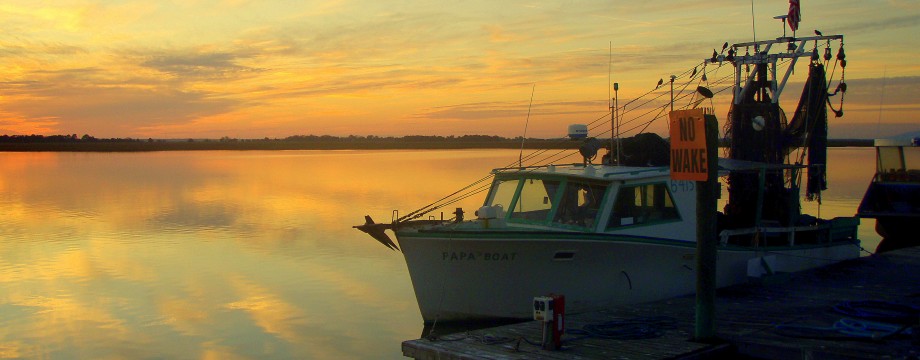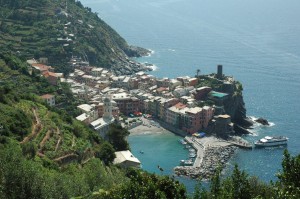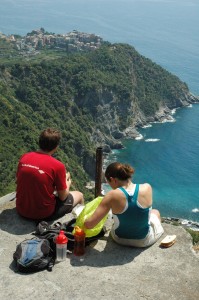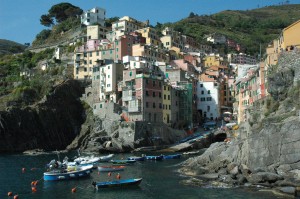Like lichens clinging to rock, the five cliff-side villages of Italy’s Cinque Terre lie harmoniously between sea and slate in a land much forgotten by modern man.
Today, trains link these sleepy villages bringing a flow of tourist dollars to the hardworking hands of local farmers and fishermen. Not long ago, one’s livelihood was directly tied to the backbreaking labor that comes with life on the edge of the earth.
Perched precipitously on sheer rock faces, the towns of Riomaggiore, Manarola, Corniglia, Vernazza and Monterosso still bring to life a brilliant example of an ingenious and persistent people carving a living out of rock. Men still pull fish from the sea in small row boats navigating narrow harbors and women continue to tend cliff-side gardens while vineyards grow on frightening slopes.
Connecting this row of towns is a winding hiking trail often no bigger than a goat path. Climbing and descending rapidly in altitude, the paths linking each town attract adventurous tourists awarding them with magnificent views and lush landscape. Be sure to pick up a hiking pass from park offices at train stations in Cinque Terre. After the four to five hours it takes to hike from one end to the other, plus time exploring each town, the €1.80 train ticket fits well into any budget at the end of a long day.
Along the trail between towns we met a newlywed couple on their honeymoon. Few places on Earth can match the romantic qualities of the Italian Riviera. The sun sets over the Mediterranean casting golden rays and melting hues on the plaster homes. The light show is adequately accompanied by a soundtrack orchestrated upon the rocky coastline.
Below the heights ascended by passersby, waves crash upon the craggy shoreline. Only the largest of the five towns, Monterosso, can claim an actual beach by definition; however others offer flat rocks covered in sunbathers and calm waters for swimming. At the southern end of Cinque Terre, Riomaggiore is home to an atypical beach covered in large rocks and even larger boulders but the hard surface is not enough to deter the scantily clad from catching rays at the water’s edge.
Each town has its own distinctive characteristics and flavor, yet each town is similar in the sense which connects the villagers through a rich and difficult history. Now protected as a national park, Cinque Terre also lies on the UNESCO World Heritage list for its harsh beauty and unique development in an otherwise uninhabitable landscape.
Located two hours north of Pisa, who’s tower is worthy of a quick day trip, Cinque Terre is a certifiable Italian jewel; although it doesn’t make everyone’s European itinerary. Only personal recommendations carried us to Cinque Terre which easily holds its own with the continent’s top destinations.
After being lured to the intrigue of these towns by the glowing reviews of others, no expectations were left unmet by the fusion of civilization and nature as entire villages seemed to flow into the sea. Although Cinque Terre is quickly gaining in popularity amongst tourists, there is still an unmistakable charm found where only train and foot traffic can go.
There are no McDonalds in Cinque Terre, no strip malls or department stores. Doorways are short, hallways are narrow and stairwells are steep. There was little to no thought placed upon convenience in the design and construction of these towns, only survival. As the area undergoes its birth pains from swelling tourist traffic, guests can benefit from the gradual adjustments.
There are no Marriotts or Hiltons and only Monterosso can boast seaside resorts. Opt instead for an apartment and get a feel for local life. Often tucked away in hidden streets away from the main drag, apartments can be rented from management companies or directly from the owner. Aided to find budget accommodations by the tourist information office, we found ourselves sharing a two bedroom apartment with an elderly Italian woman speaking no English. Our conversations consisted mainly of charades and check-in was a bit dicey, but breakfast, served each morning on the balcony, certainly made up for any inconvenience.
A distinct lack of vehicles may remind travelers of a distant time, where hotels can’t be found and supermarkets are rare. While enjoying these subtleties of Cinque Terre life, pick up some locally produced pesto from any roadside food market, wine shop or vegetable stand. The distinctly Italian sauce, pesto takes a turn from the typical in Cinque Terre. A simple concoction of basil, olive oil, pine nuts and salt, the green culinary staple finds a regional addition of fine cheeses including a blend of pecorino and parmesan.
This additive creates a unique and creamy pesto sauce with savory cheesy undertones masked by the strong basil and earthy pine nuts. All of it blended with the freshest, high-quality olive oil straight from the source makes for a delicious additive to pasta dishes or slathered on some bread.
There’s no shortage of picturesque scenery or memorable moments on the road from Riomagiorre to Monterosso, but the real treasure lies in the essence of each village, a feeling that can’t be captured in photos. As tourists gain knowledge of this tucked away paradise, traffic will surely increase. Be sure to make your way to Cinque Terre before it becomes just another stop along the way.







